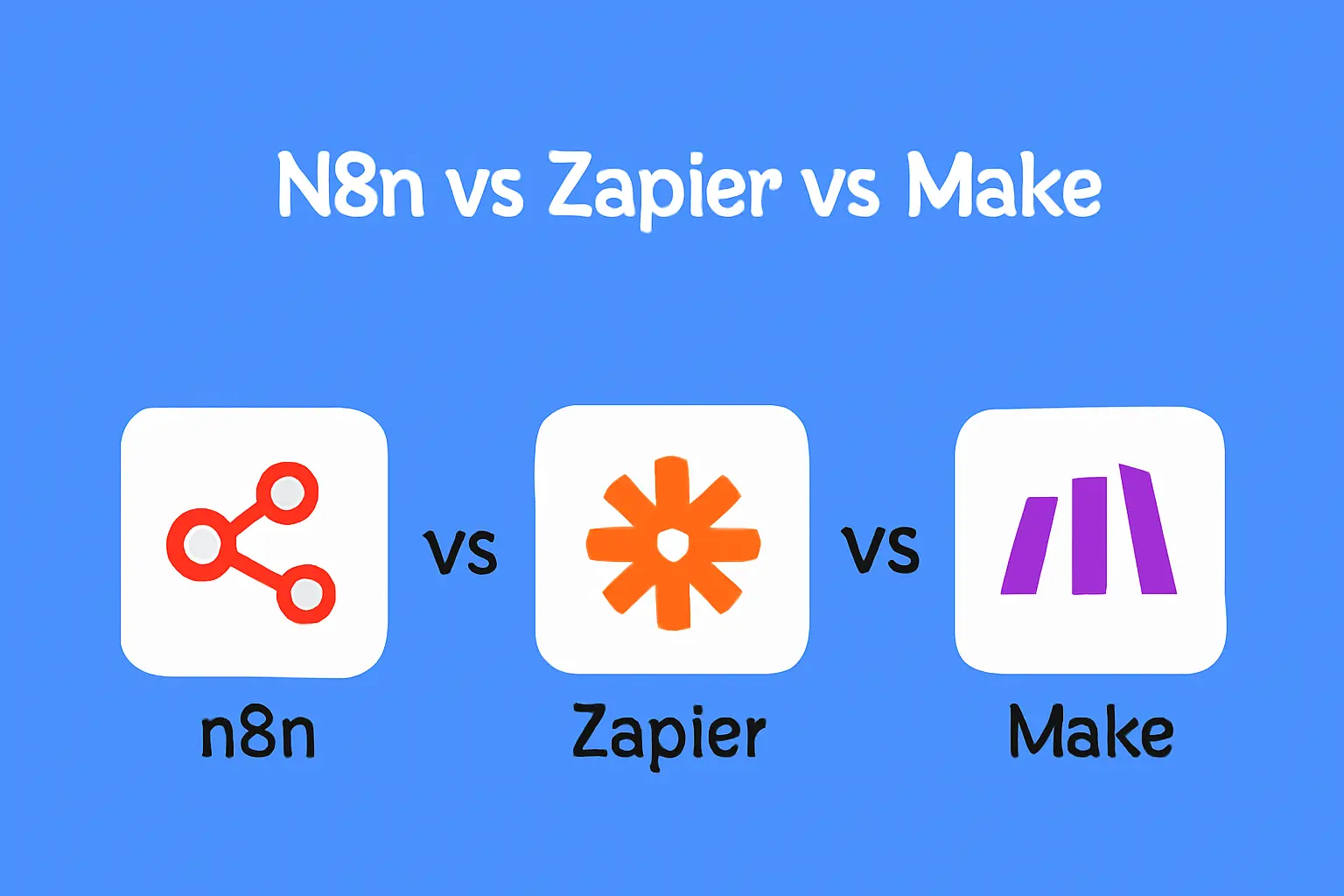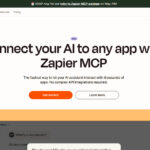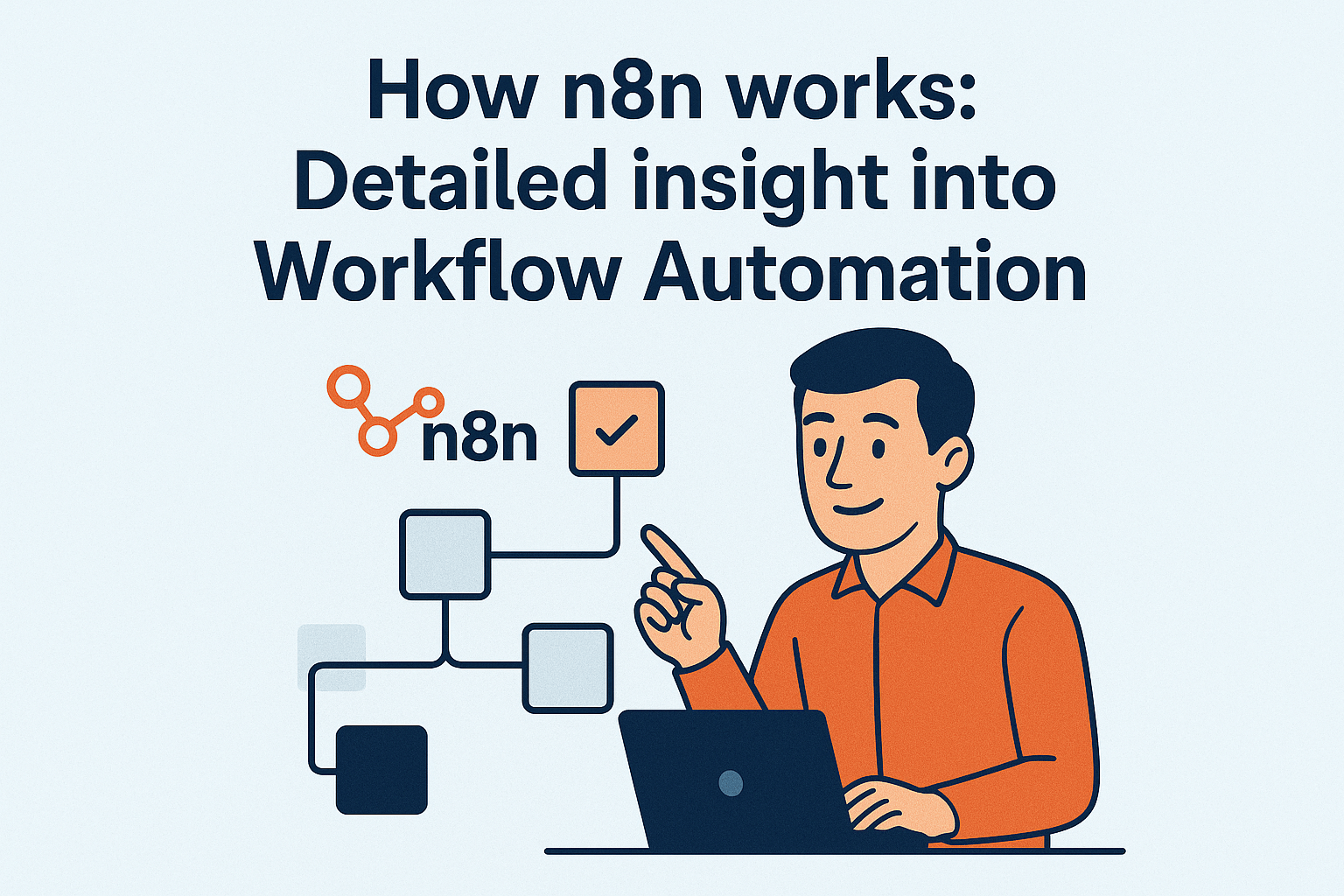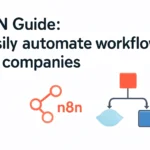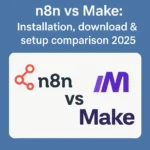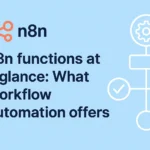Workflow automation tools like Zapier, Make.com and n8n help you eliminate repetitive tasks and connect apps. The right platform can save your team hours every day and reduce errors at the same time. Find out which tool is best suited to your requirements here.
Which automation platform will make your company faster?
Imagine if your team had eight hours more time per week – without overtime, without hectic, simply thanks to automation. Sounds inevitable? No wonder: 40% of routine work in marketing & product development can be automated today – if you choose the right tool.
The three most popular solutions on the market are Zapier, Make and n8n. What makes them different? More than you think – especially if your setup is growing or you’re looking for maximum control. Zapier runs on rails: from simple email automation to daily dashboard updates, ready to go in minutes. Make brings complex processes to the canvas – visual, transparent and ideal for anyone who doesn’t want to write code yet. And then there’s n8n. The self-hostable tool for the tech-savvy, fully customizable and completely free if desired.
Why is choosing the right provider more than just a matter of taste? Wrong decisions cost you money and make your processes less scalable in the long term. It’s about more than integrations – it’s about: 1. Flexibility to also work with AI and custom workflows. 2. Cost control so that your budget doesn’t evaporate into task limits. 3. Freedom from errors so that you can sleep soundly with processes that run at night. After just a few months, the choice of tool separates high performers from busy work chaos in the team. The optimal choice depends directly on your technical skills, the scope of automation and your budget – the more complex your workflows, the more you will benefit from the extended possibilities of Make and n8n.
Ready to finally scale your organization’s automation level properly? Let’s get started with the ultimate comparison between n8n, Zapier and Make!
The 3 leading workflow automation tools at a glance
- Zapier dominates the market with over 6,000 available integrations and a simple interface that gives even non-technical users immediate access. Perfect for quick standard automations.
- Make (formerly Integromat) scores with visual workflow creation and more complex logic functions at a moderate cost. Ideal for teams that need more flexibility without having to delve too deeply into the technology.
- n8n is an open source alternative, revolutionizes cost efficiency: you can host the Community edition completely free of charge or choose a paid cloud-based plan that you can adjust to your workload. n8n often is significantly cheaper than competitors. It will give you maximum customizability.
Results: Comparison of Zapier vs. Make vs. n8n
The right platform choice depends on your technical know-how, the volume of automation and your budget expectations – although even small companies can save hours a day through automation.
| Criteria | Zapier | Make | n8n |
|---|---|---|---|
| Link | Free Trial | Free Trial | Free Trial |
| Ease of Use | ⭐⭐⭐ Very simple, form-like interface; beginners friendly; ready templates; setup in minutes |
⭐⭐ Visual drag-and-drop canvas; moderate learning curve; 2+ hours to master complex workflows |
⭐ Node-based interface; technical, steep learning curve; days to weeks to master |
| Pricing Model | ⭐ Task-based pricing; expensive as volume grows; free plan with 100 tasks/month |
⭐⭐ Operations-based billing; more cost-efficient at scale; free plan with 1,000 operations/month |
⭐⭐⭐ Workflow-based pricing; self-hosting free; cloud plans from €20/month |
| Cost at 50,000 Actions | ⭐ €200–400/month |
⭐⭐ €50–100/month |
⭐⭐⭐ €50/month cloud or free self-hosted |
| App Integrations | ⭐⭐⭐ 6,000+ integrations; extensive SaaS coverage; many marketing tools |
⭐⭐ ~1,500 integrations; high-quality B2B/e-commerce focus |
⭐ Around 1,000 native integrations; unlimited via custom API and open source approach |
| AI Integration | ⭐ Basic AI (OpenAI, limited options); increases task costs |
⭐⭐ Visual AI workflows with multiple providers; moderate flexibility |
⭐⭐⭐ Most advanced AI support: OpenAI, Claude, Hugging Face, custom models; full customization |
| Advanced Workflow Logic | ⭐ Basic if-then logic; limited conditional branching; no complex nesting |
⭐⭐ Supports complex conditions, loops, filters and error paths without coding |
⭐⭐⭐ Full programming logic using JavaScript; unlimited branches and conditions |
| Error Handling & Monitoring | ⭐ Basic retry mechanisms |
⭐⭐ Robust error handling with detailed logs and debugging |
⭐⭐⭐ Advanced error handling with local log storage; GDPR-friendly |
| Team Collaboration & Roles | ⭐ Role-based permissions from €99/month plan |
⭐⭐ Granular roles and permissions |
⭐⭐⭐ Advanced control with versioning, granular rights; suited for dev teams |
| Best Use Cases | ⭐⭐⭐ Quick, simple automations; less technical teams |
⭐⭐ Balanced solution for mid-complexity workflows; visual but powerful |
⭐ Technical teams needing maximum flexibility, customization, and AI integration |
| Workflow Export/Import | ⭐ No native export; manual documentation required |
⭐⭐ JSON export supported; internal use only |
⭐⭐⭐ Full JSON export/import; supports migration and backup |
| Migration Complexity | ⭐ Difficult due to non-exportable workflows |
⭐⭐ Medium complexity; JSON export helps backup |
⭐⭐⭐ Easiest among three; supports import/export in JSON |
| Learning Curve | ⭐⭐⭐ Low; entry point minutes |
⭐⭐ Moderate; days to master complex workflows |
⭐ High; requires programming knowledge and time investment |
| Scalability | ⭐ Limited by high task costs at scale |
⭐⭐ Good scaling with affordable operations pricing |
⭐⭐⭐ Highly scalable; self-hosting eliminates volume costs |
| Scheduling Flexibility | ⭐⭐ Basic scheduling (hourly, daily) |
⭐⭐⭐ Flexible cron-based scheduling |
⭐⭐⭐ Advanced cron scheduling with timezone support |
| Security & Data Control | ⭐ SaaS-based; limited data control |
⭐ SaaS-based |
⭐⭐⭐ Full self-hosting option for maximum data sovereignty |
| Rating | 53 % 24 of 45 stars |
67 % 30 of 45 stars |
82 % 37 of 45 stars |
| Summary | Fastest for beginners and simple tasks with biggest app library; costs rise quickly | Powerful visual builder for complex workflows at moderate price; lacks self-hosting | Most flexible, customizable, and cost-effective (self-hosted); best for advanced/AI-heavy use |
Now lets have a look at each area step-by-step.
User-friendliness
Ease of use will determine whether you set up your first automations in minutes or hours. Each platform takes a fundamentally different approach for different target groups.
Zapier: The beginner’s friend with limits
Zapier makes automation as simple as filling out a form. The platform guides you through the process step by step: select app, define trigger, set action – done.
With over 6,000 ready-made templates, you’ll find a solution for most standard workflows right away. An email newsletter automation between Mailchimp and Google Sheets is ready to use in under five minutes.
The catch: as soon as you need more complex logic – such as conditional branching or data manipulation – Zapier reaches its limits. Multiple consecutive “if-then” conditions require separate zaps, which quickly becomes confusing.
Make: Visual clarity meets flexibility
Make impresses with its drag-and-drop canvas, on which you create workflows like a flowchart. You can immediately see how data flows through your automation and where branches occur.
The learning curve is more moderate than with n8n, but steeper than with Zapier. After about two hours of training, you will be able to handle complex scenarios:
- Conditional logic without programming
- Loops and repetitions
- Data filtering and transformation
- Error handling with alternative paths
n8n: Power for the tech-savvy
n8n is clearly aimed at developers and technical teams. The node-based interface is reminiscent of professional development environments and offers unlimited possibilities.
You can embed JavaScript directly into workflows, write your own functions and carry out the most complex data processing. The price: a steep learning curve of several days to weeks, depending on your programming skills.
The investment is worthwhile if you need maximum control over your automations and standard solutions are too restrictive.
For marketing teams without a technical background, Make is the optimal compromise between simplicity and functionality – you build complex workflows visually without having to write code.
Price models and cost comparison
The cost differences between Zapier, Make and n8n can have a dramatic impact on your budget for high volumes of automation. While Zapier scores points with small teams, it quickly becomes a cost factor for larger projects.
Zapier: Task-based billing with rapidly rising costs
Zapier’s pricing model is based on so-called “tasks” – each individual action in your workflow counts as a separate task:
- Free version: 100 tasks per month, 5 zaps
- Starter plan: 20 euros per month for 750 tasks
- Professional: 49 euros per month for 2,000 tasks
- Team Plan: 103 euros per month for 10,000 tasks
💡 Tip: A simple lead-to-CRM workflow can already consume 3 to 5 tasks – that adds up faster than expected.
Make: Operations model with better scaling
Make bills via “Operations”, which is significantly more cost-efficient for more complex workflows:
- Free version: 1,000 operations per month
- Core plan: 9 euros per month for 10,000 operations
- Pro plan: 16 euros per month for 10,000 operations plus extended features
With 50,000 monthly operations, you pay around 50 to 100 euros – a fraction of the Zapier costs.
n8n: Workflow-based pricing with open source option
n8n offers the most flexible cost model with a unique self-hosting option:
- Self-hosted: Completely free with your own infrastructure
- Cloud Starter: 20 euros per month for 5,000 workflow executions
- Cloud Pro: 50 euros per month for 10,000 executions
Concrete cost comparisons for your planning
The following costs are incurred for 50,000 monthly automation actions:
- Zapier: 200 to 400 euros per month (depending on the plan)
- Make: 50 to 100 euros per month
- n8n: 50 euros per month or free with self-hosting
Beware of hidden costs: Premium integrations and extended features can incur additional fees – this is increasingly the case with Zapier in particular. Choosing the right tool depends less on the entry price than on your planned scaling volume and the technical expertise of your team.
Integration options and app ecosystem
The number of available integrations regularly determines the success of your automation strategy. While all three platforms offer solid connections, they differ significantly in the scope and depth of their app ecosystems.
Zapier: The undisputed integration giant
With over 6,000 app connections available, Zapier dominates the integration field. The platform covers virtually every SaaS application that marketing and sales teams use on a daily basis.
Zapier’s particular strengths:
- Most comprehensive coverage of consumer apps and marketing tools
- New integrations are added weekly
- Plug-and-play connections without technical configuration
Make: quality instead of quantity
With around 1,500 integrations, Make focuses on sophisticated, feature-rich connections. Instead of superficial connections, Make offers deeper control over data formats and workflow logic.
The platform excels particularly in e-commerce and business tools where complex data manipulation is required. Fewer consumer apps, but more precise B2B integrations.
n8n: Unlimited flexibility through open source
With around 1,000 native integrations, n8n initially seems limited. However, its unique selling point is its unlimited API integration: any application can be connected via HTTP requests.
n8n benefits for tech teams:
- Community nodes continuously expand functionality
- Custom API integrations without waiting time
- Complete control over data formats and authentication
💡 Tip: Zapier is sufficient for marketing teams with standard tools. If you need special APIs or custom developments, n8n is the most cost-effective solution.
The choice depends on your technical know-how and the number of special tools you want to automate.
Advanced features and customizability
The differences between the three platforms become particularly clear when it comes to more complex automation requirements. While Zapier focuses on simplicity, Make and n8n offer increasingly powerful tools for sophisticated workflows.
Conditional logic and workflow branching
Zapier is limited to basic if-then logic in the Professional and Team plans starting at €49 per month. You can set up simple conditions like “If email address domain = company.com, then score 10”, but more complex nesting is not possible.
Make comes with native support for complex conditions and loops directly in the visual editor. For example, you can create iterative processes that run through lists of contacts and perform different actions for each one individually – without any programming knowledge.
n8n offers complete programming logic through JavaScript integration. You can write your own functions, dynamically query external APIs and even integrate machine learning models directly into your workflows.
Error handling and workflow monitoring
Professional automation requires robust error handling. All three platforms offer automatic retry mechanisms, but differ in the depth of monitoring.
Make and n8n lead the way in monitoring and debugging: Detailed logs show every processing step, data structures and error locations. 💡 Tip: n8n stores execution data locally, which can be crucial for GDPR-critical workflows.
Team collaboration and rights management
Role-based access control is essential for medium-sized teams and larger. Make and n8n offer granular authorization systems for workflow editing, while Zapier only provides these features from 99 euros per month in the team plan.
n8n also scores with version control for workflows – perfect for development teams who need to track changes and roll them back if necessary.
The investment in advanced features pays off: Teams save 60 to 80 percent of the time on complex automation projects compared to basic tools.
AI integration and modern automation
The integration of artificial intelligence in workflow automation is currently revolutionizing marketing and business processes. While all three platforms offer AI features, they differ significantly in terms of depth and customization options.
n8n: The AI automation champion
n8n currently offers the most advanced AI integration of all three platforms. The platform has dedicated nodes for:
- OpenAI GPT models with full prompt control
- Claude by Anthropic for complex text analysis
- Stable Diffusion for automated image generation
- Hugging Face Models for specialized machine learning tasks
What’s special: You can integrate and fully customize your own AI models via API connections. JavaScript integration enables data pre-processing and complex prompt engineering strategies.
Make: Visual AI workflows for beginners
Make scores with its visual AI workflow creation. Standard providers such as OpenAI, Microsoft Cognitive Services and Google Cloud AI can be linked via drag-and-drop. The platform excels with:
- Automated content moderation for social media
- AI-supported lead qualification
- Image analysis and categorization for e-commerce
Limitation: Less flexibility with custom prompts and limited connection of experimental AI services.
Zapier: Basic AI features
- Zapier offers basic AI integration mainly via OpenAI and a few other providers. The configuration options are limited – ideal for simple use cases such as automatic email summaries or content translations.
- Cost trap: AI actions quickly use up the task limit, which can significantly increase the monthly costs with intensive AI usage.
- For serious AI automation, there is currently no way around n8n – the combination of native AI nodes, custom model support and free self-hosting option makes it the first choice for AI-intensive workflows.
Background: What are workflow automation tools and why do you need them?
Workflow automation tools are digital bridges between your apps and services that perform repetitive tasks without manual intervention. They work according to the simple if-then principle: as soon as a certain event occurs in one app, they automatically trigger actions in other applications.
Definition and basic principles of workflow automation
Automation eliminates human intervention in standardized processes. Imagine this: A new lead enters your web form – within seconds, they automatically land in your CRM, receive a welcome email and your sales team gets a Slack notification. These tools give you three decisive advantages:
- Time savings: up to 40 percent less manual work for routine activities
- Error reduction: Standardized processes prevent human transmission errors
- Scalability: Automations work around the clock, even with increasing volumes
Typical use cases for automation in marketing and e-commerce
Concrete application scenarios show the potential of these tools:
- Lead nurturing: automatic transfer of website leads to CRM with personalized email sequences
- Social media management: cross-posting of new blog articles on all relevant channels
- Data analysis: Daily performance reports from various marketing tools in a central dashboard
- Customer service: Automatic ticket creation from emails with intelligent routing to the right team
Practical example: Marketing automation in comparison
Nothing shows the differences between the three platforms more clearly than a concrete marketing scenario. Here we analyze a typical lead-nurturing workflow that almost every company needs.
The scenario in detail
A potential customer signs up via your website form. The workflow should be automatic:
- Create a CRM entry with contact details
- Perform lead scoring based on industry and company size
- Start a personalized email sequence
- Create a task for the sales team for highly qualified leads
Zapier: Simple, but limited
- The reality: You need four to five separate Zaps for this workflow. Zapier only allows you to map basic if/then logic, complex scoring algorithms are hardly possible.
- The set-up effort is minimal – everything is up and running within an hour. However, you quickly reach its limits: Behavior-based segmentation or dynamic email content require workarounds.
- Cost: Around 49 euros per month for the Professional plan to maintain sufficient task limits.
Make: The visual all-rounder
- One workflow for the entire scenario – that is Make’s great strength. The drag-and-drop interface shows all branches clearly at a glance.
- Complex scoring algorithms are easily possible. For example, you can score leads with enterprise email domains higher or start different email sequences based on the lead source.
- Set-up time: Two to three hours for a fully developed workflow.
- Cost: 16 euros per month for the Pro plan is more than enough.
n8n: Maximum flexibility
- Complete customizability is n8n’s trump card. You can integrate your own scoring models, use JavaScript for complex calculations and even incorporate machine learning.
- The workflow allows you to react dynamically to user behaviour, automatically evaluate A/B tests and generate personalized content in real time. However, this requires a solid technical understanding.
- Cost: 20 euros per month in the cloud or completely free with self-hosted installation.
The choice depends on your technical know-how and the desired complexity. Zapier is sufficient for standard processes, for sophisticated marketing automation there is no way around Make or n8n.
Migration and platform change
Switching between automation platforms requires careful planning, as it is not possible to migrate directly between n8n, Zapier and Make. The different workflow structures and data formats make a manual transfer unavoidable.
Workflow export and import options
- Zapier does not offer a native export mechanism for complete workflows. You have to document each Zap manually and record the trigger conditions and actions in detail.
- Make allows you to export scenarios as JSON files, but these are not compatible with other platforms. The export function is primarily used for backup and internal reuse.
- n8n supports both the import and export of workflows in JSON format. This flexibility at least facilitates documentation and internal migration between n8n instances.
Transition strategies for existing automations
The most successful migration strategy is to run both systems in parallel during a transition phase of two to four weeks. This ensures that critical business processes are not interrupted. A step-by-step migration significantly reduces risks:
- Start with non-critical workflows as a test case
- Transfer a maximum of two to three automations per day
- Validate each migrated workflow over several days
- Document differences in functionality for the team
Common pitfalls when switching platforms
Trigger definitions vary greatly between platforms. What works in Zapier as “New row in Google Sheets” potentially requires a more complex webhook configuration in n8n.
API rate limits differ drastically. Make counts every API request as an operation, while Zapier defines tasks differently. n8n has no limits of its own for self-hosted instances, but is subject to the limits of the connected services.
The biggest challenge is data format incompatibilities. Zapier’s simplified data structures must regularly be converted into more complex formats for Make or n8n.
A successful migration requires realistic scheduling of at least four to six weeks and a dedicated team member to provide technical support for the transition.
Conclusion
The choice between n8n, Zapier and Make will determine the success of your automation strategy for years to come. Each platform has its merits, but the right match depends on your specific requirements.
Summary and Highlights:
- Ease of use varies greatly between the three platforms: Zapier offers a form-like, simple introduction for beginners, Make impresses with its visual workflow representation with a moderate learning curve, while n8n offers maximum flexibility for technically experienced users.
- Cost efficiency differs dramatically with increasing automation volumes: Zapier quickly becomes expensive with its task-based pricing model (up to 400 euros per month for 50,000 actions), while Make and n8n only cost 50 to 100 euros for the same volume or even remain free of charge with n8n through self-hosting.
- App integrations determine your options: Zapier leads with over 6,000 connections for standard marketing tools, Make focuses on higher quality integrations for 1,500 apps, and n8n enables unlimited API connections through its open source approach.
- AI integration is the key factor for the future: n8n offers the most comprehensive AI support with direct connectivity to OpenAI, Claude and custom models, while Make enables visual AI workflows and Zapier only provides basic AI functionality.
- Complexity of automation determines the choice of platform: Zapier is sufficient for simple if-then scenarios, while Make enables more complex branches and loops and n8n offers unlimited possibilities through JavaScript integration and complete programming logic.
While Zapier offers the quickest entry point, it quickly becomes a cost factor for growing teams. Make delivers the best price-performance ratio for medium complexity, and n8n revolutionizes cost efficiency with maximum control through open source flexibility.
Your next steps to optimal automation:
- Analyze your volume: realistically estimate your monthly automation actions
- Evaluate your technical know-how: An honest assessment of your programming skills will save you frustration later on
- Start with a pilot project: Test your favorite platform with a non-critical workflow
- Plan for scaling: Consider growth from the start when choosing a platform
- Document your workflows: Regardless of the platform – good documentation is worth its weight in gold
Start your first automation quick win today: Choose a simple, recurring process from your daily work routine and automate it within the next 48 hours.
The best automation platform is the one you actually use – not the one with the most features on paper. The time to act is now.

